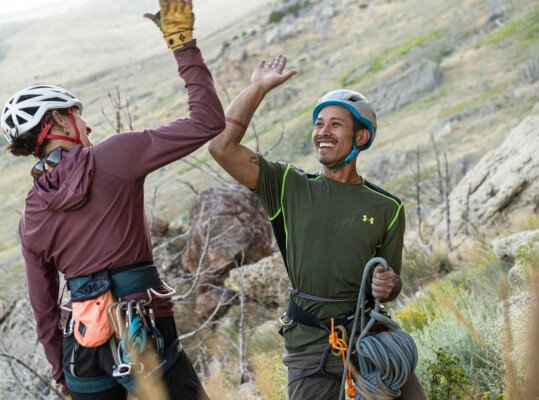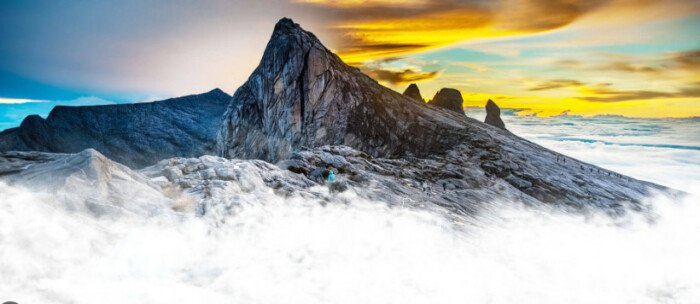Mountain climbing isn’t just about reaching the summit; it’s about respecting the environment and the community that shares your passion. Upholding mountain climbing etiquette is crucial to ensure the safety and enjoyment of all climbers, as well as preserving the natural beauty of these awe-inspiring landscapes. In this guide, we unravel the unspoken rules and best practices every climber should embrace.

Research the Destination
One of the primary etiquettes of mountain climbing is thorough research about your chosen mountain. Understanding the terrain, climate, and local regulations helps you prepare adequately. It’s essential to be aware of any restrictions, permits, or sensitive areas to plan your climb responsibly and avoid damaging the environment.
Understanding the unique characteristics of the mountain you’re climbing showcases respect for nature and fellow climbers. Equip yourself with knowledge to make informed decisions and contribute positively to the climbing community.
Respect the Leave No Trace Principles
A fundamental aspect of mountain climbing etiquette is abiding by the Leave No Trace principles. This means leaving nature as you found it, and minimizing your impact on the environment. Pack out all trash, dispose of waste properly, and avoid picking plants or disturbing wildlife. By treading lightly and leaving minimal evidence of your presence, you preserve the mountain’s beauty for future generations.
Leaving no trace extends to respecting others’ experience. Keep noise levels down, yield to other climbers on the trail, and refrain from monopolizing scenic spots. Everyone deserves the chance to connect with nature and relish the tranquility of the mountains.
Stick to Designated Trails
Preserve the delicate mountain ecosystem by staying on designated trails. Avoid cutting switchbacks, creating new paths, or trampling on vegetation. The trails are carefully planned to minimize environmental impact while ensuring climbers’ safety. Straying from these designated routes can lead to erosion and irreversible damage to the mountain’s ecosystem.
Respect for the trail showcases your understanding of the delicate balance between human enjoyment and environmental conservation. It allows for the sustained enjoyment of these natural wonders for generations to come.
Practice Good Campsite Etiquette
If your climb involves an overnight stay, practicing good campsite etiquette is paramount. Set up camp in designated areas to avoid disrupting vegetation. Keep a tidy camp, secure your food to prevent attracting wildlife, and refrain from using soap or detergents near water sources. These simple practices ensure minimal impact on the ecosystem and maintain the pristine beauty of the mountain.
By adhering to proper campsite etiquette, you contribute to a harmonious camping environment and demonstrate your commitment to preserving the natural landscape.
Be Considerate of Fellow Climbers
Mountain climbing often involves sharing the trails and campsites with other climbers. Being considerate of fellow climbers is a fundamental etiquette. Yield to faster climbers, communicate effectively, and offer assistance when needed. Building a sense of camaraderie among climbers fosters a positive climbing experience for all.
Understanding and valuing the community of climbers around you adds to the richness of the climbing journey. It’s about more than just reaching the summit; it’s about the collective adventure and mutual respect.
Stay Informed about Weather Changes
Weather in the mountains can be unpredictable and potentially hazardous. Mountain climbing etiquette dictates staying informed about the weather forecast and being prepared to alter your plans if needed. Ignoring weather warnings not only endangers your life but also the lives of fellow climbers who may need to rescue you.
Prioritize safety and respect for others by heeding weather advisories and making responsible decisions based on the information available.
Limit Group Size and Noise
To minimize impact and maintain a serene mountain environment, limit your group size. Large groups can overwhelm trails, campsites, and the overall experience for other climbers. Additionally, keep noise levels to a minimum to allow everyone to enjoy the peaceful beauty of the mountain.
By maintaining a smaller group and respecting noise levels, you contribute to a more intimate and respectful climbing environment.
Express Gratitude and Respect Locally
Finally, a key part of mountain climbing etiquette involves expressing gratitude to the local community. Respect their traditions, customs, and the land you’re privileged to climb. Engage with locals respectfully, whether it’s acknowledging their assistance or supporting their businesses. Leave a positive impression on climbers, fostering a welcoming atmosphere for future climbers.
Showing gratitude and respect to the local community enriches your climbing experience, creating lasting memories and fostering meaningful connections.
Final Thoughts
In conclusion, embracing mountain climbing etiquette isn’t just about following rules; it’s about embodying a mindset of respect for nature and your fellow climbers. By adhering to these unspoken guidelines, we ensure that the mountains we love remain awe-inspiring for generations, fostering a culture of sustainability and harmony within the climbing community. Happy climbing, and remember, respect is the highest peak!
You will find the following information useful:


